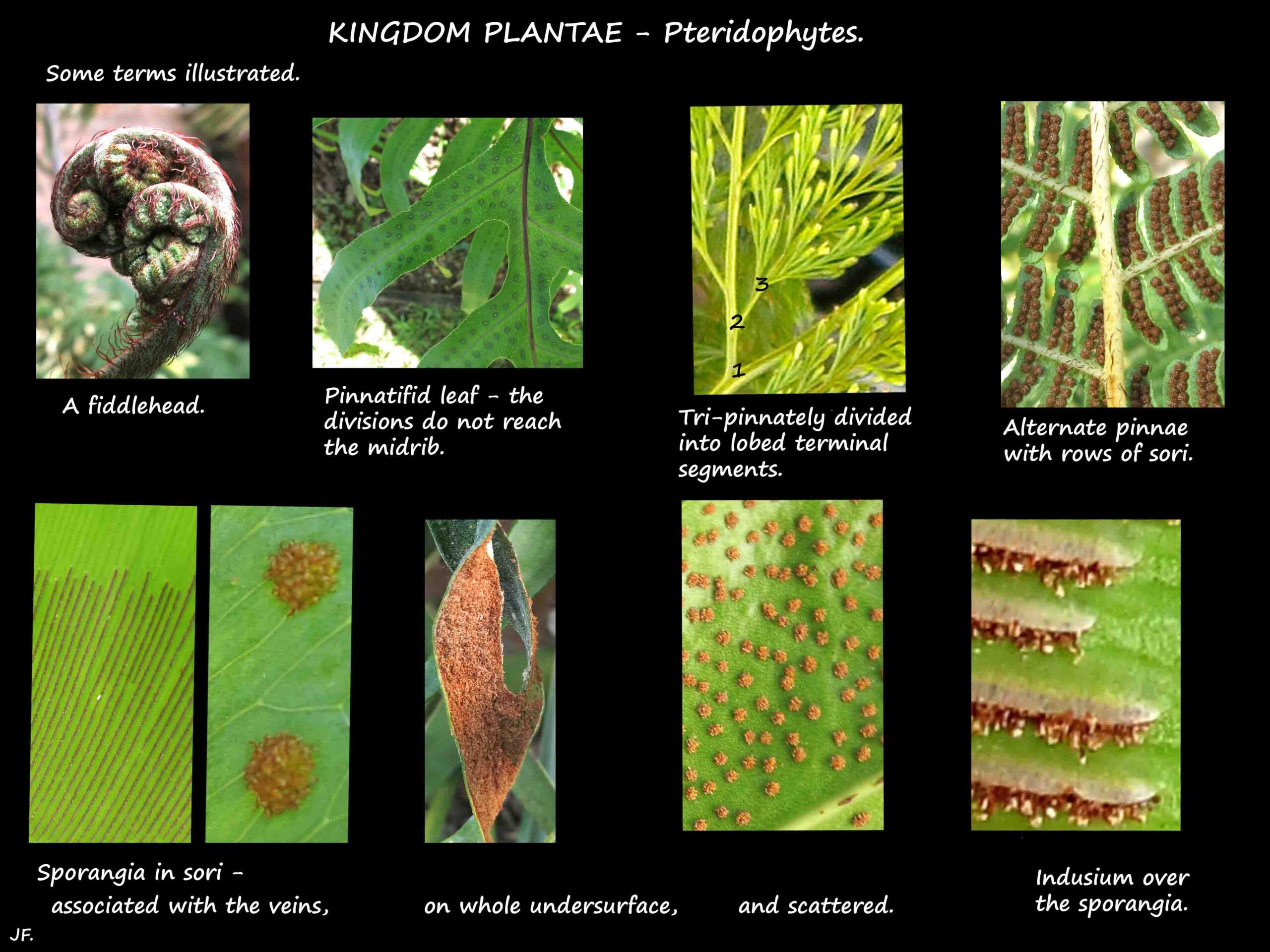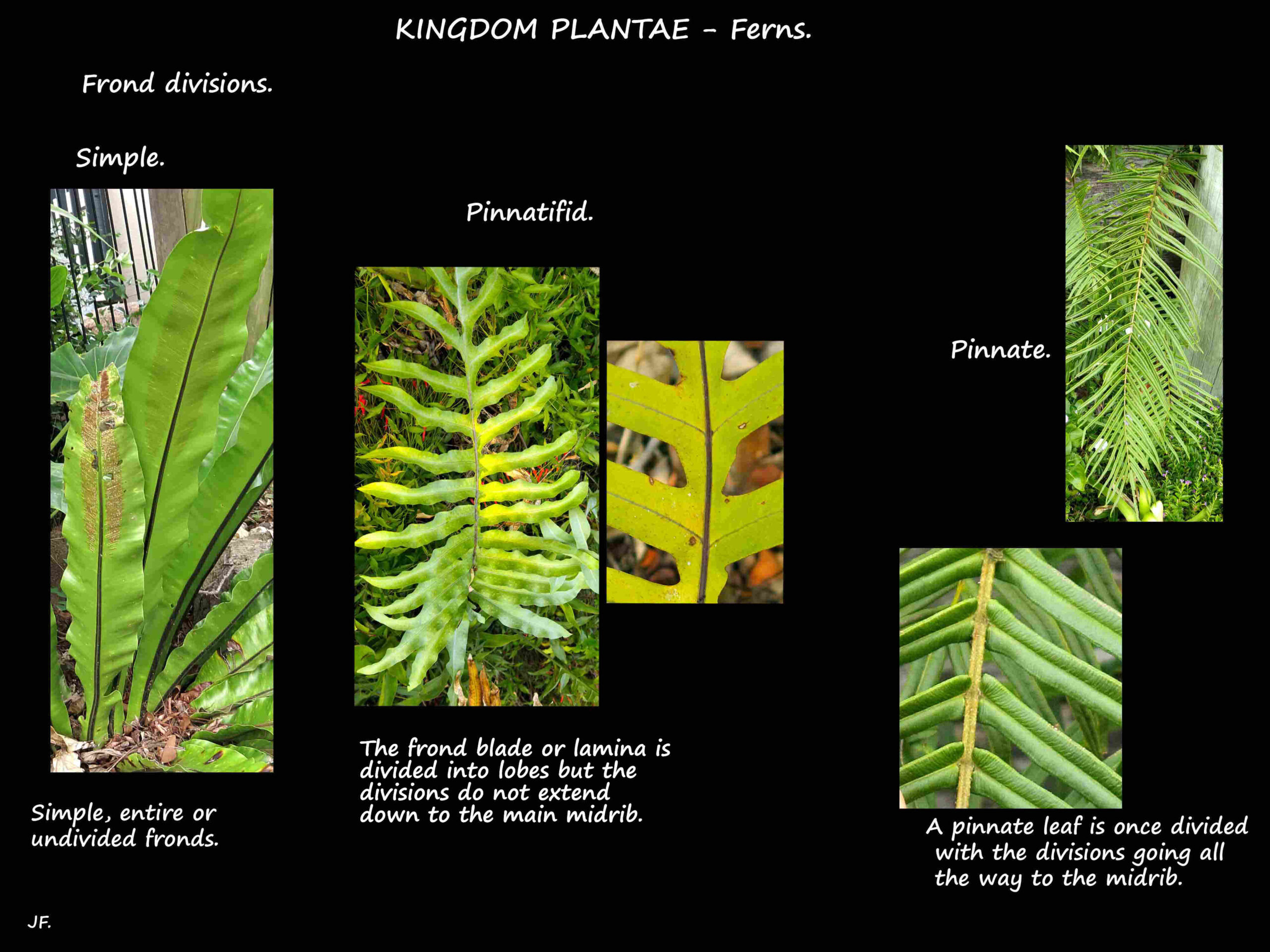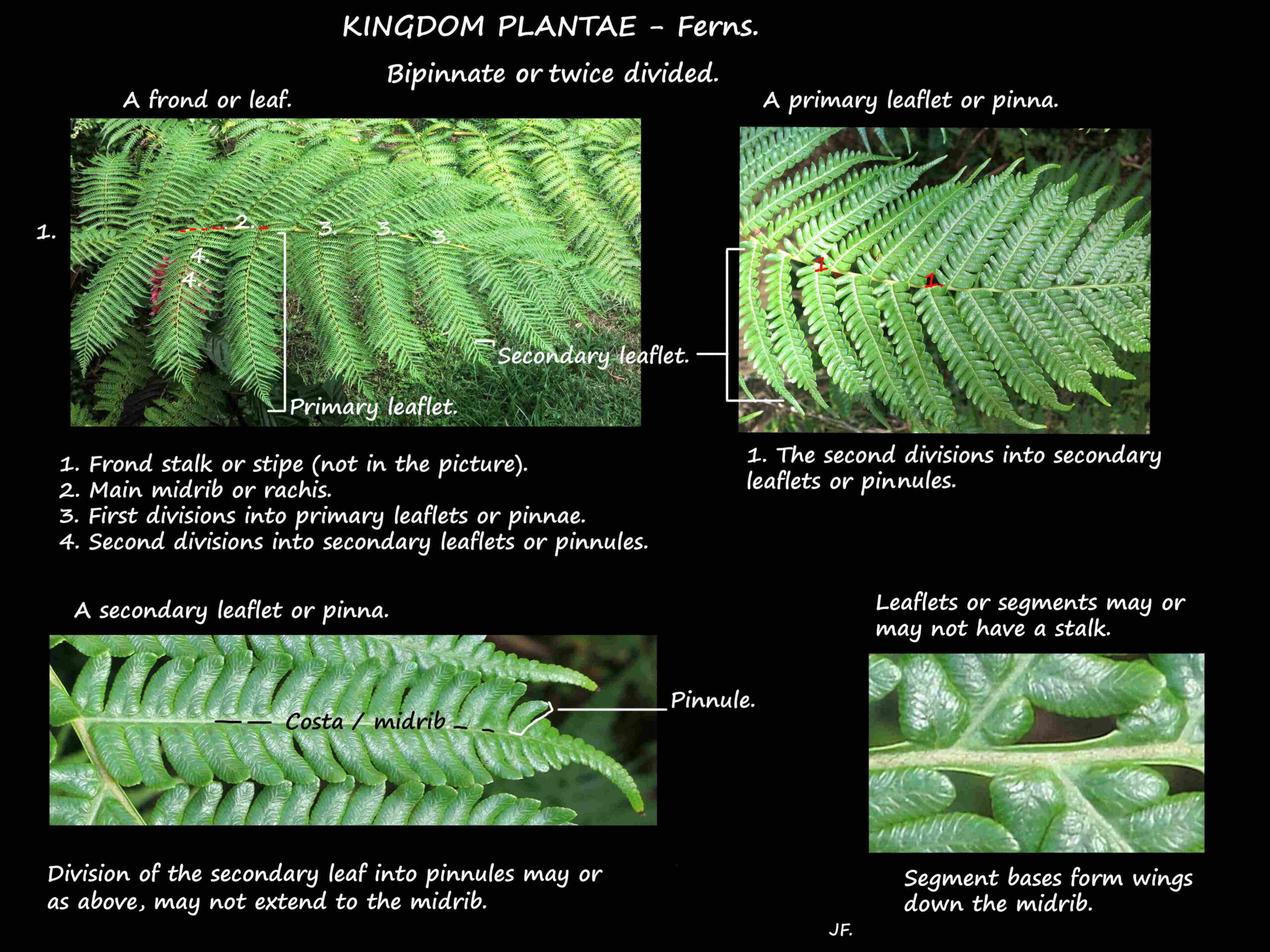Fern classification, structure & life cycle
1. Introduction to ferns.
Ferns are plants that have a vascular system to transport water and nutrients.
They also have true or complex leaves, produce no seeds and the sporophyte stage is the dominant one.
As an ancient species, appearing about 360 million years ago, they show a great variations in form and size.
Some look very different from what we commonly call ‘ferns’.
Many have died out but there are still up to about 20,000 species.
They can live in most habitats and the sporophyte (fern) can be from a few mms up to 20 metres tall.
Ferns and fern allies can been divided into two groups based on the sporangia:
1. The more primitive Eusporangiate ferns have sporangia that develop from numerous cells.
They are very large and contain thousands of spores.
2. The Leptosporangiate sporangia arise from only one initial cell and are much smaller.
The walls consist of only one layer of cells and each sporangium produces relatively few spores.
The sporangia are often collected in groups called sori or occasionally in specialised sporocarps.
- New growth is in the form of ‘fiddleheads’ that uncoil into fronds.
- Ferns in this group are referred to as the ‘true ferns’.
- There are 45 to 50 families and Australia has ferns from 25 to 30 of them.
- The numbers vary depending on how they are classified.
*************
2. Classification of ferns.
People use different classifications of ferns and these change as new information emerges.
A. Eusporangiate ferns.
Division Lycopodiophyta, Families are –
- Lycopodiaceae (Club mosses, Lygodium),
- Selaginellaceae (Spike mosses) and the
- Isoetaceae (Quillworts).
Often called the Fern Allies, they have flattened sporangia that dehisce transversely.
They also have sporophytes on leaves.
Division Pteridophyta.
- Class Equisetopsida with horsetails and scouring rushes.
- Class Psilotopsida with whisk ferns and moonworts.
- Class Marattiopsida, marattioid ferns resemble leptosporangiate ferns but have eusporangiate sporangia.
B. Leptosporangiate ferns.
Division Pteridophyta > Class Pteridopsida or Polypodiopsida, are the true ferns.
Most of the leptosporangiate ferns have a special method of spore release involving an annulus.
Osmundaceae have sporangia that are intermediate between the eu- and lepto-sporangiate groups.
*************************
Fern morphology.
The fern stem or rhizome is the main growing part of the fern that produces the leaves.
It has root-like structures that anchor it and absorb water and nutrients.
Terrestrial ferns grow on soil, moss etc.
Epiphytic ferns grow on trees and can have long or short stems with fronds that are upright, arching or pendulous.
Aquatic ferns – most are subaquatic growing on or near water but a few grow in or on water.
Terrestrial ferns can have 2 types of stems:
- i.) creeping stems may be on or under the ground, may or may not branch, and the fronds can be clumped or more widely spaced.
- ii.) erect stems are usually unbranched with a terminal rosette of fronds.
- The stem can be fleshy or woody and some with very long stems can be like small trees.
- The trunk-like structure of a tree fern is a large rhizome.
A stolon is a long above ground runner growing from the main stem that produces new plants at the nodes.
Fern leaves, fronds or megaphylls.
New leaves begin as a small, tight coil or fiddlehead which uncurls as it grows.
Fronds can be a couple of cms up to a metre or more in length.
They are usually spirally arranged or in staggered rows although some are in whorls.
There are 2 types of leaves:
- i.) vegetative leaves (tropophyll) involved only in photosynthesis and
- ii.) fertile leaves (sporophyll) that photosynthesise but also produce spores.
In some ferns the two types are very similar, in others the fertile ones are modified.
A frond is the entire leaf and consists of:
- i.) a stipe or stalk (the petiole in flowering plants) connecting the leaf blade or lamina to the rhizome.
- Some fronds have no stipe with the leaf blade connected directly to the stem.
- ii.) rachis – the central midrib that holds the leaflets is an extension of the stalk.
- iii.) the leaf blade (lamina) can be undivided or compound and divided into pinnae.
- The pinnae can be further divided into pinnules.
Some ferns have juvenile leaves which become compound as they grow.
Sometimes the frond is only divided once and is said to be pinnate.
More frequently the leaflets divide a second (bipinnate), third (tripinnate) or more times.
In pinnatifid leaves the divisions in the blade do not quite reach the midrib making them look deeply lobed.
The leaflets (pinnae) are mostly alternately arranged or sometimes almost opposite.
The leaf lamina can be thin or stiff, fleshy or leathery, dull or shiny, smooth or hairy and have a waxy coating.
Some ferns form small vegetative buds or bulbils on the fronds which can fall off and produce a new plant.
Sporangia.
Most “true” ferns (leptosporangiate), have sporangia with an annulus which assists spore dispersion.
The annulus.
Its shape and size varies among species — it can be a circle, patch or an arc (vertical or oblique) etc.
It consists of specialised water filled cells that have thick inner walls that are impermeable to water.
The thin outer walls allow the water to evaporate.
As the water evaporates the cells shrink and this causes the annulus to suddenly straighten.
As it straightens the opposite wall of the sporangium ruptures.
As more water evaporates from the annulus cells they fill with air.
This causes the annulus to suddenly snap back and the spores are ejected.
These 2 sudden movements can take only a couple of seconds.
********************
Life cycle of ferns.
The gametophyte.
A very thin, photosynthetic, heart-shaped or filamentous structure up to 10 mm in size.
Reproductive organs develop on the undersurface:
- The male antheridia are small sac-like structures producing motile sperm and
- The female archegonia which are flask-like structures with a single egg.
These can be on the same or different gametophytes.
The gametes each have n chromosomes and after fertilisation a new sporophyte with 2n chromosomes develops.
The sporophyte.
This is the typical fern plant with 2n chromosomes.
Spores develop in sporangia on the underside of the fronds – in some ferns on all the fronds in others only on fertile fronds.
The sporangia are typically small and develop in clusters called sori that vary in shape and arrangement.
The sori can be arranged on specific areas of the frond such as the edge or along the midrib or cover the whole surface.
They are always associated with the veins in the leaf.
Sori can be unprotected, have a membranous indusium over them, be under the inrolled frond margin or be associated with hairs or scales.
J.F.





